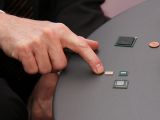Upon attending CeBIT, we've had the chance of having a very interesting conversation with two of Intel's representatives, namely Mr. Hans-Jurgen Werner, Intel Country Marketing Manager, and Mr. Zane Ball, Director of the Microprocessor Marketing Business Client Group. And as you can see as follows, we've managed to gather quite a lot of very interesting information regarding the chip manufacturer's current products and plans for the future.
Softpedia: First of all, since portability and ultra-mobile PCs are among the hottest topics today, I'll start by asking you how Intel is planning to cope with the increased competition on this market and what are you planning for this particular segment?
Hans-Jurgen Werner: As you already know, we've just announced the line of processors for ultra-mobile devices, the smallest one being formerly known as Silverthone, and now known as Atom. We've also got a companion chipset for this chip, supporting wireless communications, all of this components being known under the full name of Intel Centrino Atom mobile technology. This is what you'll find in mobile internet devices, which are even smaller than the ultra-mobile PCs.
We're talking about a very special brand of devices, which are supposed to run for 8 hours straight in active mode (not stand-by) and to be used for such purposes as browsing, social networking and even watching a movie in HD on that tiny screen. The performance and computing capacity is there. In terms of power, these processors are the equivalent of a three-year old Centrino product. Also, they're a lot smaller even than a Centrino (107 square millimeters in a Core 2 Duo dye vs. 25 square millimeters).
There are quite a lot of such ultra mobiles scheduled to arrived from our different partners in the near future, expected to arrive in Q3 and Q4 in Europe and Q2 in the US. Also, such a low power Intel architecture will be used in a car infotainment system, which is supposed to be ready by 2010.
Softpedia: Intel is a known supporter of Wimax and has helped with the deployment of Wimax within the UK. Will it do the same for the rest of Europe?
Hans-Jurgen Werner: Let's make it this way. We're talking to the regulation bodies, we're talking with the service providers in Europe. I think WiMax across Europe needs more time, as we have a very good coverage with UMTS (or 3G). I mean it's there, quite a lot of companies have invested a lot of money in the licenses, in setting up this technology, so, from this point of view you'll see a whole different speed of implementation and build-out in Europe vs. US or the other parts of the world.
This is the reason why our future products will provide multiple connectivity options. For example, in some of our future products, like the Centrino 2 (we've licensed this name as well), or the next-generation Montevino, we've combined both WiMAX and Wireless N support. For example, if a customer wants to ship its products to Asia, where WiMAX has better coverage in certain areas, it can easily do so, and the same goes for Europe, by simply changing the module.
Softpedia: What can you tell us about the Skulltrail platform? What exactly are the market segments you're targeting with this product?
Zane Ball, Director of the Microprocessor Marketing Business Client Group: The market segments targeted by the Skulltrail are the extreme of the extreme. It's obviously an extremely high-end platform. It's actually an extremely expensive solution and one of the most advanced hardware platforms for desktop computers that we could have built. This is why we don't anticipate that there will be millions of people buying Skulltrail, which wouldn't be necessarily good for the environment.
Softpedia: Actually, that's another question related to the Skulltrail. How can you comment on the fact that this is not exactly the most energy-efficient platform around?
Zane Ball: Well, anything with multiple graphic cards, multiple CPUs, something that's taken everything we could throw at it, something that it's the biggest and baddest thing that we could have created, can't be exactly energy efficient. I want to mention that there are already some applications that can use all this horsepower, especially for the media enthusiasts, who'll find that what they can do with this platform is actually pretty incredible. In essence, it's a lot of computing power.
Hans-Jurgen Werner: And I would also like to mention that, despite not being the most energy efficient platform around, it does provide one of the best energy consumption / computing power ratios, far better than anything we've come up with in the past. In absolute numbers, when you're working with several graphics cards, for example, the values are higher, but the ratio is quite good.
Softpedia: Speaking about processors, when do you think that quad-core processors will become mainstream, namely when will they become more affordable for the great majority of customers?
Zane Ball: I do believe that we have some rather mainstream offerings up today. On the future, I think that you'll continue to see a lot of quad-core solutions targeting let's say the upper segment of the mainstream systems' market. I think that here in Europe, in the main retail shops, you'll see plenty of quad-core offerings at some pretty reasonable system price points.
Softpedia: And what do you think that the lowest price point for quad cores will be ?
Hans-Jurgen Werner: I think that the lowest price, in Euro, will be of around 90.99.
Zane Ball: So this is where we are today. They'll come down a bit in the future, but I don't think that quad-cores will ever hit the "2.99" kind of space. Neither I think that it needs to. You need to have a balance. I think that quad-cores are pretty mainstream today, especially for their specific target audience.
However, I'd like to point out something here, related to the dual-core processors, especially to the 45 nanometers offerings, as they're offering a whole new level of power. We've actually made a little demonstration with one of the processors using the new dual-core technology, the E8000 series. We did a little video encoding test, a comparison between the E8000 and our quad-core Q6600, which is our highest-volume/lowest price quad core today, but is built using the old technology. And the new dual core is actually capable to compete with the quad-core in terms of video encoding performance, thanks to some better frequencies, larger cache and the new HD Boost capability that's helping software vendors create things like video encoding applications.
Softpedia: So these new offerings could prove to be quite a good solution for multimedia applications and living-room computers?
Zane Ball: Absolutely. Moreover, these new dual-core processors will be available at some very affordable price points, and will have the performance of last year's quad-core. Now, 45 nanometer technology and HD Boost technology were also applied to quad-cores, which means that this year's quad-cores are also a little up as well. And even moving next year, into the Nehalem generation, which is our next major generation of processors, we will still have dual-core Nehalems, as this new technology can make dual-core a very compelling solution for the mainstream price points.
It's also important to note that the quality of the cores matters a lot, because a better core can actually improve the overall quality of the whole product.
Softpedia: What can you tell us about the new Quick Path Interconnect technology, which will replace the FSB in the new Xeon Dunnington CPUs? Which are its advantages over FSB?
Zane Ball: Quick-Path is a high-speed, point-to-point interconnect, which is whole new type of technology. On the other side, the Front-Side Bus is what we call GTL technology and has a shared-bus architecture. There are some advantages to FSB, I mean it's very simple to add supplementary processors to the system bus. It also has a very low latency, so FSB has done a very good job for us for a very long time, as it's a very flexible and good technology.
What Quick-Path brings to the party, for servers especially, is that the bandwidth requirements have increased quite a lot, so it's better to use a direct, point-to-point interconnection. So, from the server point of view, it will be an outstanding architecture, and we're pretty proud of it, and we're looking forward to it being implemented into our future products.
Softpedia: Does Intel have any plans to go into the high-end GPU market?
Zane Ball: We've been present on the GPU market for almost a decade now, and we think we're the market leaders in this respect. Unfortunately, I'm not very familiar with the discrete graphics market.
Hans-Jurgen Werner: We can't disclose any of the discrete graphics plans for the time being. But we can talk about Larabee, a processor that can be used for different types of tasks and environments. Thus, it can be used in the scientific world, in the HPC (high-performance computing) world, and perhaps even in the visual world. This is how we see it currently.
As for discrete graphics, i don't know. But at least have the fundamental element, and we're working on that fundamental element in order to offer a much improved processor.
Softpedia: We've tackled this subject because we've also attended your competition's press conference, and they had some rather harsh words to say regarding the differences between their new 780G series platform and anything Intel has to offer. How can you comment on that?
Zane Ball: The 780 is an integrated graphics chipset. And in any integrated graphics-related discussion, discrete graphics is also a very important subject to bring up. I think that those who are really into 3D gaming and outstanding gaming performance, there are a lot of discrete gaming cards out there that deliver these features.
As for integrated graphics, Intel also has a very strong roadmap ahead. The future Intel products will also be able to deliver very good quality graphics, fully-integrated Blu-ray playback capabilities, HDMI integration, content protection, management features, and more. And if you're into 3D gaming, I do believe that you can build at any time a better gaming machine based on an Intel solution.
Hans-Jurgen Werner: And I'd also like to add a second piece to that, namely the fact that we're trying our best to close the gap, from the point of view of manufacturing technologies, between the chipset and the chip. Practically, by adopting the 45-nm technology, one gets more transistors, which can basically be used for graphics.
Of course, we'll focus on the future on improving our integrated 3D graphics technologies. Up until now we've focused on improved quality, driver stability, etc., some very important points for business customers.
Zane Ball: And actually, that's still very true on the market today. The chipsets that sell in the highest volumes are those value solutions that really do seem to resonate the most with our consumers. And I will re-state: on-time performance, driver stability, everything that business users appreciate. I think that most people who are into gaming will chose a discrete graphics solution, and there's a rather thin market of casual gamers who will probably choose an integrated graphics solutions. Intel is also delivering such products, we're not the only ones, but we do have to keep the product perspective in mind, because most of the market is interested in product stability, performance, driver stability, a great foundation around which you can configure a number of different capabilities.
Softpedia: Do you think that there will be a significant market for quad-core CPUs for the notebook segment?
Hans-Jurgen Werner: There will be quad-cores coming to notebooks. We demonstrated back at IDF a notebook offering this kind of capabilities, we've shown that it's working, but, of course, we're talking about a different power envelope. So yes, you will see notebook quad-core coming, but mostly for gamers, extreme editions, and so on.
Live report by Bogdan Popa and Alex Vochin from CeBIT 2008 Hanover, Germany.

 14 DAY TRIAL //
14 DAY TRIAL // 

